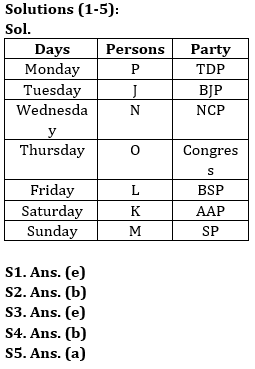Directions (1-5): Study the following information carefully and answer the questions given below:
Seven persons of different parties have voting in different days of a week which starts from Monday and ends on Sunday.
At least three persons have voting after J who is from BJP. Three persons have voting between J and K who has voting just after the person who is from BSP. L has voting just before the person who is from AAP and just after the person who is from Congress. M has voting after the person who is from AAP but not on Saturday. N has voting before the person who is from SP and after the person who is from TDP. Person who is from NCP has voting before O and after P.
Q1. Who among the following is from TDP?
(a) J
(b) K
(c) L
(d) M
(e) None of these
Q2. Which of the following party belongs to O?
(a) BSP
(b) Congress
(c) SP
(d) TDP
(e) None of these
Q3. In which of the following day the person who is from SP has voting?
(a) Tuesday
(b) Wednesday
(c) Thursday
(d) Friday
(e) None of these
Q4. How many days gap between the voting of O and P?
(a) One
(b) Two
(c) Three
(d) Four
(e) None of these
Q5. Four of the following five are alike in certain way and hence form a group, find the one which does not belong to that group?
(a) M-SP
(b) J-NCP
(c) N-Congress
(d) O-BSP
(e) L-AAP
Directions (6-10): In the following questions assuming the given statement to be true, find which of the conclusion(s) among given conclusions is/are definitely true and then give your answers accordingly.
Q6. Statements: C ≥ D < E ≤ F, A > B = C, F < G ≥ H
Conclusions: I. C ≥ H
II. D < G
(a) Only I follow
(b) Only II follows
(c) Either I or II follows
(d) Neither I nor II follows
(e) Both I and II follow
Q7. Statements: V > N ≥ G = H, T = R ≤ Y < V, H < J ≤ S
Conclusions: I. V > H
II. T ≤ J
(a) Only I follow
(b) Only II follows
(c) Either I or II follows
(d) Neither I nor II follows
(e) Both I and II follow
Q8. Statements: M = O > J ≥ N, P ≤ L ≤ M, N > U < H
Conclusions: I. P ≤ O
II. M > U
(a) Only I follow
(b) Only II follows
(c) Either I or II follows
(d) Neither I nor II follows
(e) Both I and II follow
Q9. Statements: N > F < T ≤ R, Y ≥ H = N, R = D > S
Conclusions: I. Y ≥ F
II. F < D
(a) Only I follow
(b) Only II follows
(c) Either I or II follows
(d) Neither I nor II follows
(e) Both I and II follow
Q10. Statements: U = T ≥ R, M < K ≤ A, P > Y ≥ U, R > C = M
Conclusions: I. U > M
II. C < A
(a) Only I follow
(b) Only II follows
(c) Either I or II follows
(d) Neither I nor II follows
(e) Both I and II follow
Solutions

Solutions (6-10):
S6. Ans. (b)
Sol. I. C ≥ H – False
II. D < G – True.
S7. Ans. (a)
Sol. I. V > H – True
II. T ≤ J – False.
S8. Ans. (e)
Sol. I. P ≤ O – True
II. M > U – True.
S9. Ans. (b)
Sol. I. Y ≥ F – False.
II. F < D – True.
S10. Ans. (e)
Sol. I. U > M – True.
II. C < A – True





 GA Capsule for SBI Clerk Mains 2025, Dow...
GA Capsule for SBI Clerk Mains 2025, Dow...
 The Hindu Review October 2022: Download ...
The Hindu Review October 2022: Download ...
 ECGC PO Cut off 2025 Out, Check Final Cu...
ECGC PO Cut off 2025 Out, Check Final Cu...




